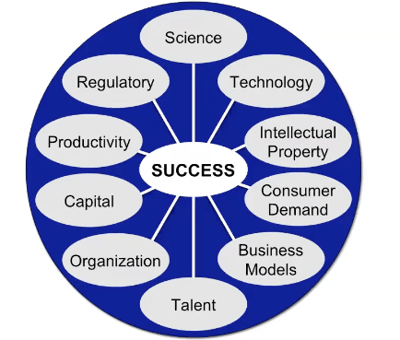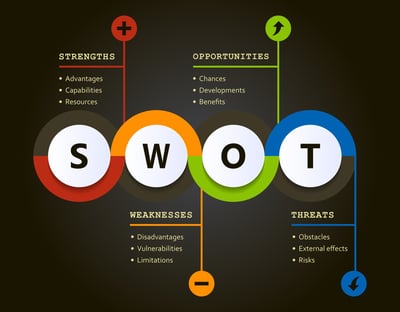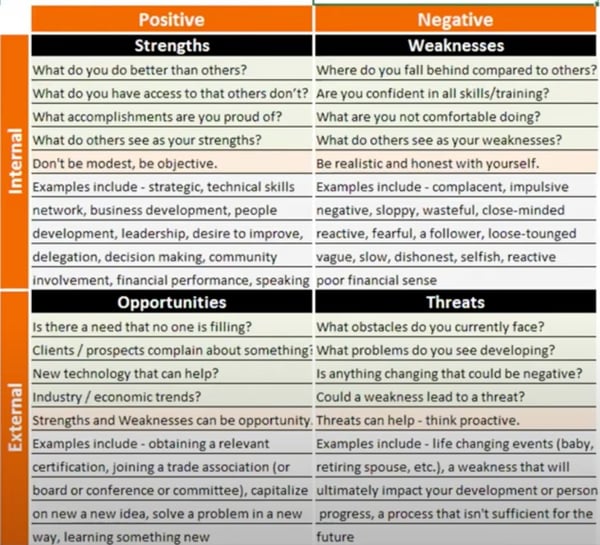No one sets out to have a business fail and yet many entrepreneurs skip essential steps in the planning and preparing stage that can help them avoid pitfalls and minimize risk. True business success depends on a variety of coordinating attributes, both internal and external, that help entrepreneurs prepare for business processes and the key components of running a business.. Inventors and innovators cannot rely on science or intellectual property to maintain a successful business. Successful entrepreneurs and business owners understand and monitor factors beyond their control such as regulations or consumer demand.
One preliminary business step to help ensure you’ve got a strong sense of what those factors may be is to complete a SWOT analysis. In fact, to best prepare, completing both a personal SWOT analysis as well as one for the business is strongly advised.

A SWOT Analysis (Strengths, Weaknesses, Opportunities, and Threats) is a brainstorming tool used during the strategic planning process. Completing a SWOT Analysis is essentially taking a long, hard look at how your idea could become a company. While extremely beneficial during the business planning phase, a SWOT Analysis could be done at any phase in the development or maintenance of an organization. A business SWOT analysis helps assess internal (employees, technology, resources, processes) and external factors (competition, legal or regulatory compliances, market strength/demand), as well as current and future potential for a small or medium-sized business.
Because SWOT is a simple, visual tool that does not require a high level of technical knowledge, algorithm, or mastery, anyone (and everyone) considering business investments should complete one.
One of the biggest benefits of a business or personal SWOT analysis is it gives you a complete and holistic view of the potential of you and your business to meet challenges, make decisions, leverage advantages, mitigate risks, allocate resources, and gain alignment from stakeholders on strategic plans.
To complete a SWOT analysis, all you really need to know how to do is identify and categorize a variety of factors and gauge their potential impact on your business. The chart below provides a basic layout for a SWOT analysis.

More specifically, attributes you or the business already possess which are helpful to achieving business or personal objectives are considered a strength. Conversely, external factors that are harmful to achieving the objectives are considered a threat. To complete a SWOT Analysis, you need to create questions centered around these 4 categories. Based on the answers to these questions, you can then take action to address those factors. This is where strategic planning and organizational alignment become essential to your success. A SWOT analysis is a tool to help you, your team, or your business, determine your next steps.
Factors to Populate SWOT
While a personal SWOT analysis may be limited to an individual, a business SWOT analysis should be completed with a group of diverse stakeholders representing a variety of opinions and backgrounds.
Because the goal of a SWOT is to look at your business objectives in a data-driven, non-emotional way, seek out stakeholders with different perspectives and backgrounds. This is the best shot at getting a complete analysis of your business from as many angles as possible. These stakeholders provide their expertise and experience as well as facts and data to drive their answers for the SWOT matrix.
Having a group with many different views and experiences can also help eliminate potential blindspots or biases. Individuals in your organization who take on assignments that give them insight and previous knowledge on your business, product, or market should be selected. People without experience or education in the field may add value, however, gathering people who are already educated can be more helpful and insightful.
While base knowledge and industry experience are immensely helpful, your SWOT analysis group members may also want to prepare and do some research before reconvening with stakeholders and completing a SWOT Analysis. In order to get the best results, it should not be a "spur of the moment" task. The group should set aside a reasonable amount of time, perhaps a 4-hour time block, leaving enough time for them to gather resources and information prior to meeting.

Now that we have an idea of what a SWOT analysis is, we can look at the 4 categories and what they mean. Below you can also get a good idea of the types of questions you might want to ask for each category.
Strengths, of an individual or business,are internal and positive in nature. Strengths typically help you strategize to leverage advantages and mitigate risks. When it comes to biotech companies, failing to identify one’s strengths can mean a lot of effort without much to show, if the strengths aren’t applied strategically. In contrast, companies that understand and apply their strengths to the appropriate tasks and objectives typically find more success. The more strengths a company has, the less risk it will bring. Seems obvious right?
Here are a few questions to help shape a SWOT discussion about a company’s strengths:
For a SWOT analysis, weaknesses are internal and negative. As an investment vehicle, biotechnology companies are inherently very risky. Weaknesses inside your company will increase that risk, identifying weaknesses early is critical for course correction, strategic planning, and being prepared to talk to potential investors.
Below are some questions to ask a SWOT group relating to a company’s weaknesses:
Opportunities are external and positive. Agile companies can take advantage of opportunities even if they cannot control their timing. Successful organizations actively seek opportunities, sometimes even creating them, instead of waiting for them. If you can take advantage of your opportunities, you can reduce your company’s risks in the long run.

Some questions you can ask about your company’s possible opportunities include:
Threats are external factors that, ultimately, threaten or challenge your chances of success. Despite the fact that you cannot control them, they have the potential to increase risks for you and your venture.

Here are some things to ask yourself when assessing your company’s threats:

As we noted above, a SWOT analysis can be completed for a variety of purposes such as for an individual, an existing business either struggling or looking to expand into new markets, or, perhaps most commonly, for startups. For a new business, entering into the process without forethought may mean you don’t get particularly helpful results or answers, ones that will help you meet your goals. A few key things to consider when completing a SWOT analysis for a new business.
1. Decide on the objective
Many times, a SWOT is used to decide whether or not something is worth the cost it incurs. This could be cutting ties from a university, putting out a first product, etc.
2. Research your market
The best way to create a useful SWOT is to research and understand your potential competitors and the industry in general. Only then can you understand how your proposed idea will fit in. Additionally, later, this will help you recognize opportunities!
3. Find a group
Decide who to have in your SWOT group. While it’s completely up to you, be sure to consider some of the best practices we’ve noted above. Choose individuals who are knowledgeable about the product, issue, market, industry, and who have diverse opinions and roles.
4. Identify and evaluate strategic factors
Focus on the internal factors first, as you have control over those. How can you leverage the strengths, diminish the risk, and plan your best moves given what’s in front of you?
5. Learn from this experience and be prepared to revisit your SWOT analysis
As markets change and new ideas come about, you should be ready to perform more SWOTs. Reevaluating and adjusting plans is normal for any company but especially a start-up . Evaluate where you were off and where you were on target. Whose insights were most helpful? What did you miss? What factors, if any, were miscategorized. Analyzing the initial process will help you do better the next time!
A SWOT analysis should be treated like medical care. When something serious emerges, address it, but, check ups are equally important, especially when something seems a bit off.. Performing a SWOT is not for emergencies only. Preventative care is incredibly valuable.
A Biotech SWOT Analysis Example
If this is your first time hearing about SWOT, it may seem confusing or complicated. IThe graphic below is a great example of SWOT in action. The goal of the SWOT analysis was for the company to decide whether or not it should make a peptide viral vaccine for coronavirus.
For this example, the group started with strengths, anticipated what those might be. The keyword is anticipated. In some cases, especially a preliminary SWOT analysis, participants may not know nor be able to predict everything that will happen when developing a new vaccine. Therefore, they should reassess their SWOT as they go as each category may reveal information needed for other categories..
Even if you are not in the field of creating vaccines, this example can help you understand how a company could complete a SWOT for a general biotechnology company.
The simple truth is completing a SWOT analysis is just the first step. While they can be incredibly simple and straightforward, to garner positive change and be useful, you need to take your SWOT and create a plan of action.
One of the popular methods of turning your SWOT into a plan of action is called ‘matching’. Matching comes from connecting two of the categories. For example, matching strengths to opportunities shows you areas where you can be aggressive and take action. In contrast, matching weaknesses to threats will expose areas you need to work on or things to avoid.
Below is a what is called a Confrontation Matrix, which is used to further analyze the output of a SWOT analysis. In this matrix, you can combine each category and realize the importance/relevance of each combination. Listing each category by importance can be helpful when looking for the most pertinent strengths or weaknesses.
A second popular strategy to convert your SWOT into a plan is converting. Now that you have data on the negatives (weaknesses and threats) you can start to convert them into positives. For example, if your staffing is limited, start finding ways to add additional personnel like volunteers or interns. You can also seek partnerships or seek an accelerator to convert threats/weaknesses into opportunities/strengths.
In addition to a business SWOT analysis, once can also complete one for your personal life when entering a new phase of life or facing a tough decision. Much like a business SWOT, it can help you gain a more clear view of where you stand and how best to achieve your goal.
Personal SWOTs work best when you can focus on a single goal or problem that you want to address. However, it is important to have a clear understanding of what you want before you begin. Otherwise, you might end up wasting your own time by not setting clear boundaries and expectations.
Obviously, the questions you’ll ask yourself for a personal SWOT are a bit different so here are a few things to consider:

Because you will have singular control over personal SWOTs, the best option is to convert your negatives into positives. For example, growing a skill set or finding creative ways to turn your weaknesses into strengths are great options. For instance, if your lab skills need work, consider taking a lab skills course. But, it’s not just about hard skills either. For example, if you are very outgoing, you should know not to confine yourself to an isolated work environment.
Personal SWOTs are powerful because they allow you to uncover opportunities you might not have otherwise spotted. By understanding and accepting your weaknesses, you can manage to eliminate threats that might otherwise hurt your ability to move forward.
SWOT is a simple, yet useful framework for analyzing your organization’s strengths, weaknesses, opportunities, and threats. It helps you build on what you do well, to address what you are lacking, to minimize risks, and to take the greatest possible advantage of chances for success.
But, it is not the only tool. Performing a valuable SWOT requires insight into what questions you need to ask and doing research to support the answers you need.
This information comes from a talk with Dr. John Bilello, ScienceDocs consultant, in partnership with University Lab Partners. Dr. Bilello has a PhD in Molecular Biology and was the former Director of Technology Development at GlaxoSmithKline. In addition to an established track record of innovative basic and clinical research, Dr. Bilello has experience in both project and organizational management.
If you want to learn more about business planning, check out this article from ULP about Creating an Effective Business Continuity Plan.
Be sure to subscribe to the ULP Youtube Channel to never miss another webinar, and connect with us on LinkedIn to stay in the loop!
Revised 01/02/2024
Download The Ultimate Guide to Wet Lab Incubators in Southern California, a handbook to assist life science start-ups through the entire decision-making process to find wet lab space.
Download Now